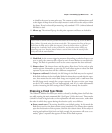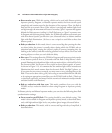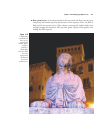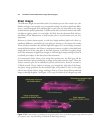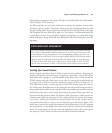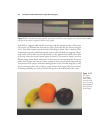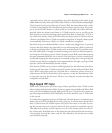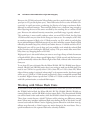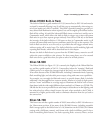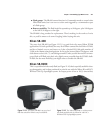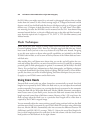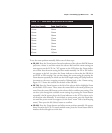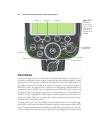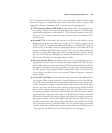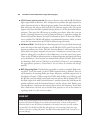Nikon D7000 Built-in Flash
The built-in flash has a guide number of 12/39 (meters/feet) at ISO 100 and must be
activated by manually flipping it up (It will also pop up automatically when using cer-
tain Scene modes any time it’s needed). This flash is powerful enough to provide pri-
mary direct flash illumination when required, but can’t be angled up for diffuse bounce
flash off the ceiling. It’s useful for balanced fill flash (more on that later) and for use in
Commander mode, which allows the built-in flash to trigger one or more off-camera
flash units in up to four separate groups wirelessly. You can use CSM #e3 to dial down
the intensity of the built-in flash to 1/128 power so that, in Commander mode, it will
activate off-camera flash units but not contribute much (if at all) to the exposure. The
built-in flash can also be set to fire only as a pre-flash that will trigger external units,
without setting off its main burst. The built-in flash has useful modeling light and
repeating flash modes, which will be described later in this chapter.
Because the built-in flash draws its power from the D7000’s battery, extensive use will
reduce the power available to take pictures. For that reason alone, use of an external
flash unit can be a good idea when you plan to take a lot of flash pictures.
Nikon SB-900
The Nikon SB-900 (see Figure 12.13) is currently the flagship of the Nikon flash line
up, and has a guide number of 34/111.5 (meters/feet) when the “zooming” flash head
(which can be set to adjust the coverage angle of the lens) is set to the 35mm position.
It has all the features of the D7000’s flash unit, including Commander mode, repeating
flash, modeling light, and selectable power output, along with some extra capabilities.
For example, you can angle the flash and rotate it to provide bounce flash. It includes
additional, non-through-the-lens exposure modes, thanks to its built-in light sensor,
and can “zoom” and diffuse its coverage angle to illuminate the field of view of lenses
from 8mm (with the wide-angle/diffusion dome attached) to 120mm on a D7000. The
SB-900 also has its own powerful focus assist lamp to aid autofocus in dim lighting, and
has reduced red-eye effects simply because the unit, when attached to the D7000, is
mounted in a higher position that tends to eliminate reflections from the eye back to
the camera lens.
Nikon SB-700
This lower-cost unit has a guide number of 28/92 (meters/feet) at ISO 100 when set to
the 35mm zoom position. It has many of the SB-900’s features, including zoomable
flash coverage equal to the field of view of a 16-56mm lens on the D7000 (24-120mm
settings with a full-frame camera), and 14mm with a built-in diffuser panel. It has a
built-in modeling flash feature, but lacks repeating flash, accessory filters, and an
Chapter 12 ■ Making Light Work for You 419



